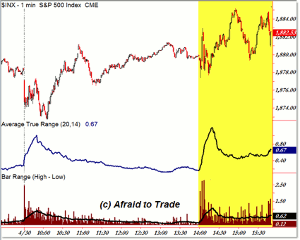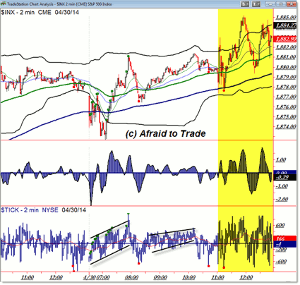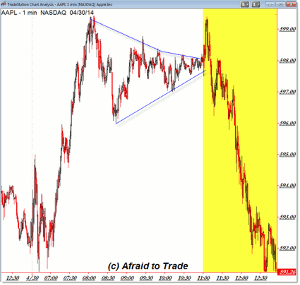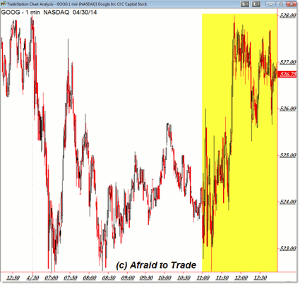Fed Days are unique events that call for increased attention and a shift in tactics, advises Corey Rosenbloom of AfraidToTrade.com.
Savvy traders know to treat Fed Days differently than normal trading sessions while new traders often get tripped up by the sudden volatility or instant shift in the rhythm of a trading session.
Let’s take a quick look at Wednesday’s Fed Day action and segment the day into “Before Fed” and “After Fed” to note specific changes in the trading day environment so we can apply these lessons on future Fed Days.
We’ll start with a pure chart of price and volatility:
The main idea here is that Fed Days are unique events that call for increased attention and a shift in tactics.
It’s best to treat Fed Days as two separate sessions—the time before the announcement, which tends to involve a compression in volatility (tightening price range/lower volatility), which gives way to a sudden burst of volatility (rapidly moving price action) that continues into the close.
Tactics and trade set-ups that work well in the morning session may fail completely in the afternoon session—resulting in significant financial losses (or profits for those who enjoy trading high-volatility environments).
The chart above shows the S&P 500 on a one-minute chart with two measures of volatility:
- Average True Range (ATR), which is a rolling total of the volatility of each bar (1-min period)
- Bar Range, which is simply the price traveled in one bar (the high minus the low of the bar)
Note how volatility was stable yet declining all throughout the morning session (times are in PST) and then compressed into icy coldness (intraday lows for volatility) just ahead of the Fed announcement. From there, volatility spiked to the highest level of the day and remained elevated into the close.
These should be treated as two separate environments:
Traders who enjoy high-volatility environments do best to avoid pre-market trading conditions while traders who enjoy lower-volatility, stable price action should end their intraday trading activities before the Fed policy is announced and not trade into the close.
Here’s another look at a typical chart of the intraday market with indicators:
While price rose steadily in an uptrend, we can see how price (volatility) compressed moving into the 11:00am PST (2:00pm EST) announcement.
I also highlighted intraday TICK—a key market internal—to note two smaller ranges of 650 (morning) and 500.
Note that TICK range surged to over 1,500 and remained elevated into the close.
I stress—the intraday trading environment is so different before and after a Fed announcement that traders often do best to treat Fed Days as two distinct sessions.
The same logic plays out in individual stocks.
I selected two examples to highlight structural shifts in two leading stocks Wednesday:
After a stellar rally in the morning, Apple’s (AAPL) price compressed into a tight (low volatility) triangle just ahead of the policy announcement.
After a final spike above $599, price collapsed, broke to the downside of the triangle (a bull trap) and then violently fell all the way back to the session low near $591 per share.
Bullish traders who did well in the morning likely had difficulty shifting into the afternoon environment.
The same logic plays out in reverse for GoogleWednesday:
After morning weakness with a fall from the session high of $528 per share, Google’s price similarly saw a compression near $524 and then an explosion higher from $523 all the way to challenge the session high.
Note also the bear trap in Google (GOOG) ahead of the reversal; it’s similar to Apple’s violent bull trap.
If you are a new trader, be sure to treat Fed Days as distinct events (trading days) where intraday conditions shift rapidly as a result of trader activity to the Fed announcement.
In simpler terms, adapt your strategies to trade either the pre-Fed reduced volatility environment or the post-Fed high volatility environment but not both (unless you are an experienced trader who can make the switch quickly).
By Corey Rosenbloom, CMT, Trader and Blogger, AfraidToTrade.com

























